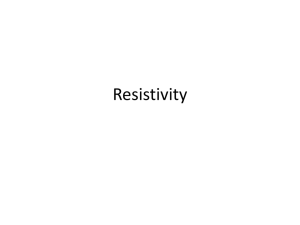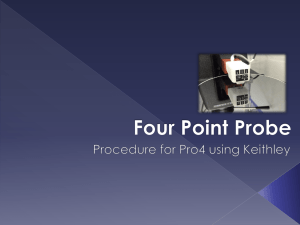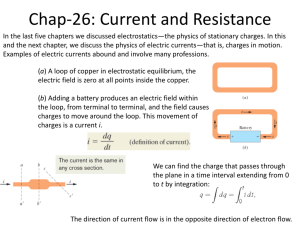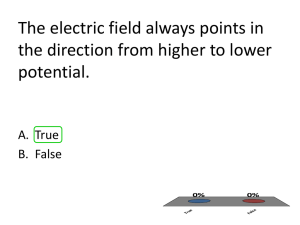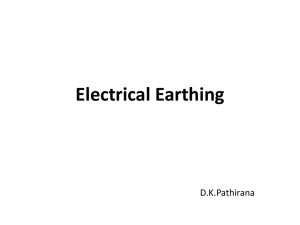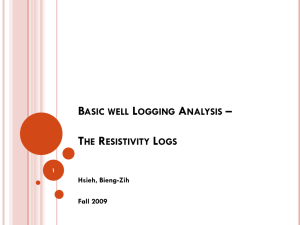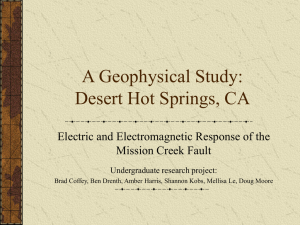Resistivity
advertisement
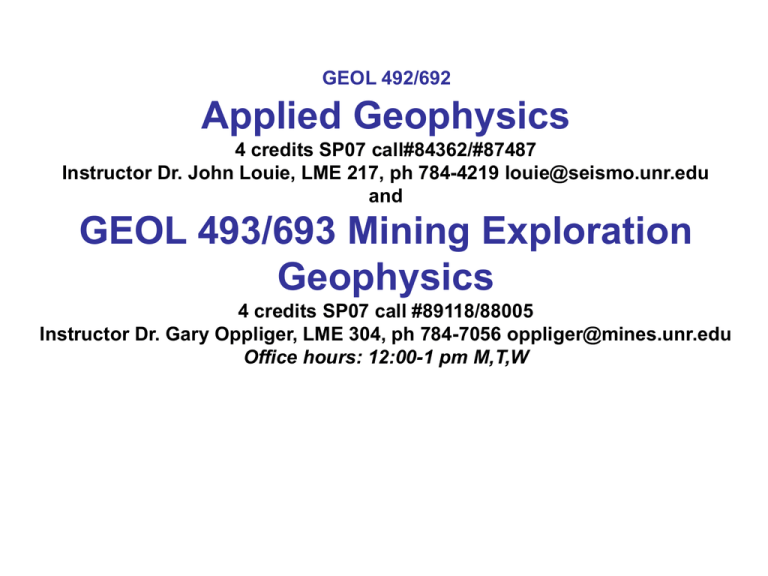
GEOL 492/692 Applied Geophysics 4 credits SP07 call#84362/#87487 Instructor Dr. John Louie, LME 217, ph 784-4219 louie@seismo.unr.edu and GEOL 493/693 Mining Exploration Geophysics 4 credits SP07 call #89118/88005 Instructor Dr. Gary Oppliger, LME 304, ph 784-7056 oppliger@mines.unr.edu Office hours: 12:00-1 pm M,T,W Electrical Properties of Rocks and Electrical Resistivity Methods Resistance Definition of an OHM An ohm is a resistance in a conductor that produces a potential difference of one volt when a current of one ampere is flowing through it. R= Ohm’s Law http://hyperphysics.phy-astr.gsu.edu/hbase/electric/ohmlaw.html#c1 Resistance vs Resistivity Resistance is relevant only to a particular measurement circuit. Units: Ohms Resistivity is an intrinsic property of all physical materials Units: Ohm-Meters Apparent Resistivity is a resistivity estimate based on a assuming a half-space geometry. Units: Ohm-meters Electrical Resistivity vs Electrical Conductivity Resistance = ρ (ohm-meters) Conductivity = σ = 1/ρ (mho/meters) Calculating Resistance from Resistivity • http://www.cflhd.gov:80/agm/index.htm Factors Influencing Electrical Conductivity in Rocks Porosity (connected/effective - fractures or pores) Pore saturation (% air or gas) Hydrocarbon Fluid Saturation Water salinity (TDS) Clay Content Metallic Sulfide Mineral Content Fluid temperature Rock Matrix intrinsic resistivity Archie’s Law Formation Factor The conductivity of most geological formations can be fit to Archie’s Law Influence of Permeability A rock with a non-conducting matrix must be permeable (connected pores) as well as porous to conduct electricity. Darcy's Law: Ohm's Law: where Despite the similarity between Darcy’s and Ohm’s Laws, electric currents have zero viscosity so even a narrow crack can provide an effective electrical connection between pores that not contribute to hydraulic permeability. Comparison of electric and hydraulic properties. Electrical • Hydraulic Transverse resistance: T = S hiri = Hrl Transmissivity: Th = Shiki= KlH Longitudinal conductance: S= Shi/ri = H/rl Leakance: Lh=Ski/hi = Kt/H Average aquifer resistivities: rl, rt Average hydraulic conductivities: Kl, Kt http://www.cflhd.gov:80/agm/index.htm Metallic Sulfide Mineral Content Electrical resistivity of rocks with various wt % of sulfide. • http://www.cflhd.gov:80/agm/index.htm Effect of Water Temperature http://appliedgeophysics.berkeley.edu:7057/dc/figures/fig43_7.jpg Conductivity Ranges of Various Materials http://www.cflhd.gov:80/agm/index.htm http://www.cflhd.gov:80/agm/index.htm http://www.cflhd.gov:80/agm/index.htm http://www.cflhd.gov:80/agm/index.htm Resistance vs Resistivity Resistance is relevant only to a particular measurement circuit. Units: Ohms Resistivity is an intrinsic property of all physical materials Units: Ohm-Meters Apparent Resistivity is a resistivity estimate based on a assuming a half-space geometry. Units: Ohm-meters Calculating Resistance from Resistivity • http://www.cflhd.gov:80/agm/index.htm Four Electrode Resistivity Measurement on rock sample … are used to avoid electrode contact resistance effects seen in two electrode measurements. current I C1 P1 P2 C2 Four electrode resistivity arrays http://www.cflhd.gov/agm/images/fig90.jpg The Basic Concept of an Earth Resistivity Measurement http://www.cflhd.gov/agm/images/fig91.jpg Electrode Contact Resistance is typically much higher than the intrinsic earth resistivity Electrode Contact Resistance is concentrated around each electrode If a standard two electrode resistivity meter were used to measure the earth’s “resistance” we only obtain information on the quality of the electrode contacts – not the earth’s resistivity Pole-Pole Array http://appliedgeophysics.berkeley.edu:7057/dc/em44.pdf Pole-Dipole Array http://appliedgeophysics.berkeley.edu:7057/dc/em44.pdf Pole-Dipole Array http://appliedgeophysics.berkeley.edu:7057/dc/em44.pdf Wenner Array http://appliedgeophysics.berkeley.edu:7057/dc/em44.pdf Schlumberger http://appliedgeophysics.berkeley.edu:7057/dc/em44.pdf Dipole-Dipole Array The electric potential varies as 1/r around a single current electrode on a homogeneous half-space Equal potential voltage surfaces between the electrodes Depth of current flow between two current electrodes One point removed C:\Shortcut to Geo-CD-ROM.exe Airborne EM Resistivity Airborne EM Resistivity http://ece.uprm.edu/~pol/waves_review.pdf http://appliedgeophysics.berkeley.edu:7057/dc/archie/index.html
